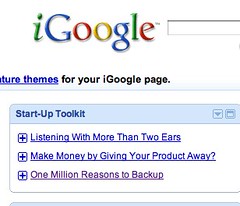‘ve been writing about having a small business website in 8 Options to Quickly Build a Web Presence for your Startup, about using a blog to promote your business in Building Success By Blogging: An Architect’s Story and even about Smart Blogging Strategies. Today we’re going to explore the magic of a technology called RSS, which stands for Really Simple Syndication. RSS lets you publish content on your site, and have other people easily view it on many other sites. For example, you could add this column to a program called a “feed reader” and then every time it is published, you would see it in your feed. You’d click on the “Feed button.”

You’ll be presented with choices — you could add the feed to your Google,Yahoo, or AOL custom home pages, or take the ‘raw’ version of the feed and add it to a program like News Gator http://www.newsgator.com/individuals/default.aspx which lets you read feeds on mobile, in windows or mac, and even within your Outlook inbox.

If you added the feed to your Google homepage it would look like this:

Or to your Google reader, it would appear like this.

As an entrepreneur, using a reader can help you control your information flow and find useful content. As a marketer, creating feeds can amplify your marketing efforts.
PRESSfeed is a company that specializes in helping PR and Marketing people and small business owners who are not technically oriented get fresh content on their own sites easily, and distribute their content it to other sites. Sally Falkow, Co-Founder of PRESSfeed, told me “Our system makes their content more visible and gets their messages to more audiences which they may not have reached. For example, for a construction industry client that does water-scapes, paving and pool surrounds, PRESSfeed got them onto the first page of Google for their search terms. When they added content regarding a new geographic location, these showed up in the targeted searches.”
In another case, a phone integrator client’s feed got added by other site, a Hispanic business site, and soon they got called by journalist from a different business magazine. Once content is in a feed, it is easy for customers who like your product to share it via sites like Delicious, Twitter, StumbleUpon, and even post links in Facebook.
According to Falkow, within 3-6 months, the feed can be a top driver traffic to website. And Google software engineer Matt Cutss has said many times that adding fresh content in a feed helps get a site better search engine ranking. “It is such an easy way to spread and distribute your content — why wouldn’t you put your content in a feed?” asks Falkow. She also notes from recently conducted research she performed that only 14% of top entrepreneurs are using feeds on their news content — so there’s an opportunity to differentiate.
Besides PRESSfeed, an easy way to have your content available in a feed is to have a blog — you can find out more about how to do that in 8 Options to Quickly build your web presence.
This originally appeared in the Inc Start-up Toolkit




